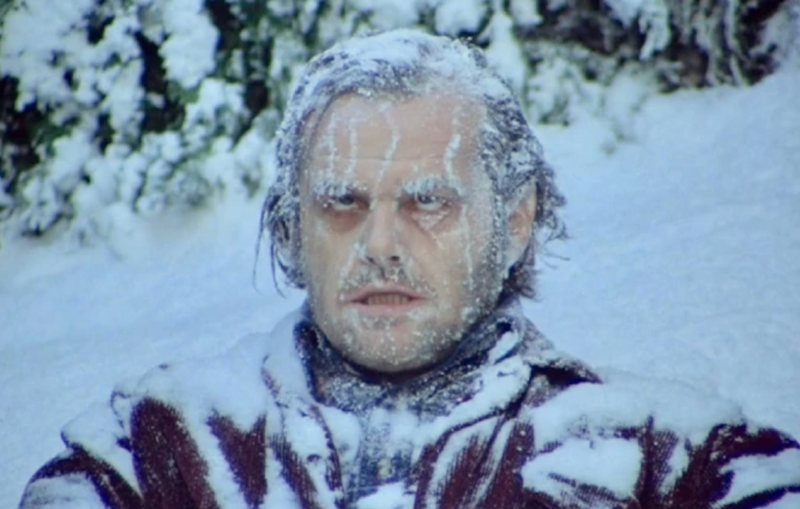I saw The Shining when it came out in 1980 and didn’t find it scary at all. Jack Nicholson and Shelley Duvall weren’t convincing, I was put off by the constant symmetry of the images and the endless Steadicam shots, thought the REDRUM business was absurd, and the last shot of Nicholson “trapped forever” in the hotel seemed lazy for wrapping up a series of loose ends. I was used to British Hammer films like Taste The Blood Of Dracula or The Curse of Frankenstein and low-budget horror films like The Phantom of Soho or The House That Screamed, a particularly gruesome film about a boy who, to please his domineering mother, the mistress of a girls’ boarding-school, creates the ideal woman out of his female victims’ body parts. Times change. Once my son asked me to show him a film that I’d found terrifying as a child. I showed him The Horror of Dracula with Christopher Lee. He was bored.
I got back into The Shining around 2010, just before the explosion of renewed interest in the film. I’d found an article about it, a great text about the references to the genocide of Native-Americans. It concerned what was visibly or audibly tangible in the movie like Native-American wall hangings, dialogue, native-like chanting in the sound track, how the Native-Americans would hide their tracks by walking backwards. I watched the film again and was hooked.
Now I’ve seen The Shining more than any other film. When I was teaching English at the French M.I.T., an engineering school called Ecole Normal Superior des Arts et Métiers, I’d show it as a Christmas film each year to all my classes. I’d always make the same joke: “Okay we’re now going to watch a Christmas film, it has a family and snow in it and takes place in the winter” and then let it rip. I’d show it in English and we’d discuss it afterwards.
Meanwhile, I’d go back from time to time and check to see if any new critiques had come out and in no time at all, there were tens and then hundreds of videos. Some of these videos dealt with the film itself, showing that the hotel was constructed in a way that was architecturally impossible (something I believe Kubrick borrowed from Poe’s story “William Wilson”) or pointing out various continuity errors, like the well-known disappearing chairs or the change in the brand of typewriter Jack uses. Others videos were free interpretations of the film. These ranged from the moon landing being faked to the USA getting off the Gold Standard, to the Holocaust. These theories always had a personal agenda, each was always presented as the “real” solution.
I’d argue that Kubrick filled the film with red herrings to keep the audience from seeing what’s directly in front of them. In The Shining there’s such a vast amount of information that you can get hung up on something, say, the omnipresent boxes of Kellogg’s Frosted Flakes featuring Tony The Tiger, or why there are bottles of 7-Up in the kitchen hallway, and miss something very simple taking place at the same time. In the opening interview between Mr. Ullman, the hotel manager, and Jack Torrance, there’s an American flag prominently in the shot, an eagle statuette on the window sill, a large red book in the corner of the shot (which depending on which video you watch is either a book by Carl Jung or a hotel registry), and a third actor, the mysterious Bill Watson, who sits there silently, observing. It’s easy to look at all that information and not listen when Ullman says to Jack that Delbert Grady (the ex-caretaker who killed his family whose job Jack will be performing) “seemed like an entirely normal individual.” But it’s important. Kubrick is telling us that Grady was a completely normal individual and that by proxy, the completely normal audience watching the film would be, under the right circumstances, capable of the same act.
Another example is when Danny, while driving to the Overlook Hotel, says he’s hungry. This segues immediately into conversation about cannibalism among the early American settlers. It suggests that it’s our biology, the simple need to eat, that’s the root cause of our actions. This may also explain why toilets figure so prominently in the film.
Finally, consider when Danny has been assaulted in Room 237. Wendy first accuses Jack of having done it and leaves the Colorado Lounge with Danny. Then the scene changes and we see Jack talking to Lloyd the bartender about when he’d hurt Danny a couple of years before. This incriminates Jack beyond a shadow of a doubt. Then Wendy says. “There’s a crazy woman in the hotel.” But since the only women in the hotel is Wendy I see this a hint that she did it and is the crazy one.

